
Features
Crop Culture
Inputs
Growing Points: Understanding how plants ‘work’
October 26, 2012 By Dr. Mohyuddin Mirza
In the first two articles in this series, I have written about the
fixing of light energy, photosynthesis, the role of carbon dioxide,
water, oxygen, respiration and stomata.
In the first two articles in this series, I have written about the fixing of light energy, photosynthesis, the role of carbon dioxide, water, oxygen, respiration and stomata. A reader has asked about the fact that if the formation of glucose is a fundamental food block for all the plants we have talked about, then how come hundreds of different compounds are made afterward.
Simply stated, once glucose is made through the process of photosynthesis, it is stored as starch and used to make fat, to make cellulose and to make proteins. After glucose is formed from carbon, hydrogen and oxygen, then come the nutrients you have supplied through your fertilizer programs.
Glucose is a combination of carbon, hydrogen and oxygen, and when broken down it provides those elements for combining with other minerals to make a vast array of chemicals and compounds. For example, chlorophyll is C55H72O5N4Mg. Thus, to make the green coloured pigment chlorophyll, elements nitrogen and magnesium have been added with carbon, hydrogen and oxygen to make a highly functional green pigment that is involved in photosynthesis.
Here’s just one more point to show how integrated the plant is and how a lack of one single element can stop everything in the chain. Growers supply all nutrients needed for growth and understand the basic logic behind providing these nutrients through different fertilizers. Nitrogen is one of the elements used in large quantities and is supplied as nitrate fertilizer, e.g., potassium nitrate or calcium nitrate.
Plant roots absorb nitrogen primarily as nitrate ions and then what happens to the roots is very intriguing and interesting.
The nitrate ion goes through a “reduction” process to ultimately convert it to a urea type of nitrogen. This requires quite a bit of energy that comes from the glucose that the leaves made. You can visualize what happens inside the cells. The nitrate ion is NO3 and has a negative charge. One oxygen is removed and it becomes a nitrite (NO2) ion, which is short-lived and toxic to plants.
Then all oxygen is removed and hydrogen is added with nitrogen, and it becomes ammonium nitrogen (NH4) and acquires a positive charge. Then two hydrogen atoms are removed and it becomes NH2, which is urea nitrogen. This is then combined with carbon and oxygen to make amino acids, which are the building blocks for proteins.
Now comes the most interesting part. A trace element called molybdenum is involved in converting nitrate to ammonium. It is one of the trace elements required in very small amounts, and I always refer it to as “Holy Moly.”
So if growers are not paying attention to this “Holy Moly,” and if it is lacking in the fertilizer program, then nitrates will not be converted to ammonium. They will start accumulating in the cells and thus proteins would not be formed and these are needed for different functions.
EXAMINING PHOTOSYNTHESIS TO RESPIRATION RATIO
■ I would like to point out the ratio between photosynthesis, where food is made, and the respiration rate, where food is utilized for energy. It is generally agreed that more food has to be made than used to make sure there is continued growth of plant parts, roots, shoots and fruit. A ratio of three-to-one between photosynthesis and respiration is considered good for plant growth and fruit yields.
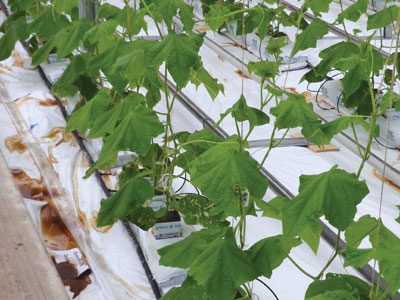 |
|
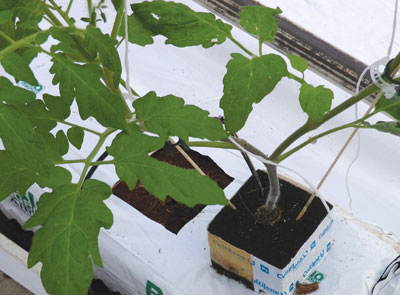 |
|
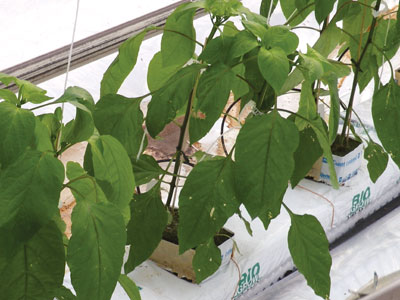
|
In November, the natural light intensity is low and the daylength is also reduced.
I have shared pictures of early stages of cucumber, tomato and pepper crops grown without supplemental lights to emphasize the fact that when photosynthesis is low, the plants will look like this. Leaves would not look dark green and you will notice that there is no fruit set on them.
In the case of cucumbers and peppers, the first flowers have been removed to make sure that photosynthetic assimilates are used to make roots and shoots and not fruit in the early stages of plant development. An understanding of temperature and its role in preparing the plant for the future is important at this stage. The temperature requirement and crop management changes as the crop sets flowers and fruits.
THE ROLE OF TEMPERATURE IN PLANT DEVELOPMENT
■ I believe that crop production of both vegetables and flowering plants is often below optimal, sometimes less than 50 per cent, due to a lack of an understanding of temperature and how it influences other environmental conditions. This is especially true for those growers who have only a thermostat to control the temperature.
Firstly, remember that sunlight coming into the greenhouse directly affects the temperature. More sunlight means higher inside temperatures, higher ventilation requirements and higher irrigation needs.
With high light, the leaf temperature will also be higher and that is important for photosynthesis, stomata opening and respiration. The leaf temperature is generally 3-5 C higher than the air temperature. I have seen a grower producing lettuce at 8 C air temperature under high-pressure sodium lights because the leaf temperature was over 14 C.
Even in winter, I have seen that on bright sunny days, the heating system does not start and the temperature could rise significantly over the setpoint unless you start venting. If growers are using supplemental lights, then the temperature could rise further.
Secondly, remember that temperature will depend on the capacity of your heating system, meaning that the system will kick in when sensors register that the setpoint temperature has dropped.
Thirdly, remember that the inside temperature will depend on the effectiveness of your venting system.
Nearly all processes of growth and development and production in greenhouses are affected and influenced by temperature. The quality of the plant itself and of the produce is affected in addition to plant health, flowering and flower development, fruit ripening, diseases and insects. Some effects of temperature are obvious, while some have a huge impact on production later in the season. Growers miss opportunities for good temperature control for a number of reasons:
- Not having good temperature controls.
- Sometimes due to limitations of outside temperatures.
- Sometimes not having a good understanding of plant response to temperatures.
- Sometimes not able to “read” the crop.
- Poor distribution of heat/temperature inside the greenhouse.
The table below emphasizes the role of temperature in truss development of tomatoes.
 |
UNDERSTANDING TEMPERATURES DURING 24-HOUR CYCLES
■ Day temperature: There are recommendations for each crop about day temperature requirements and these are primarily designed to keep the leaves warm enough for photosynthesis and transpiration. As mentioned earlier, photosynthesis is optimum between 18 and 28 C, although above 24 C, the transpiration, that is, the loss of water, could be high enough to cause problems.
For those growers who are able to measure sunlight, <500 joules is low and >1,500 is considered high.
On sunny long days, sunlight can accumulate up to 2,200 joules or even higher. So the day temperature for most greenhouse vegetable crops can be set between 18 to 25 C. This is with the understanding that temperature adjustments will be needed with each stage of crop growth and if the crop needs to be directed towards more vegetative or generative growth.
One other thing to know about the importance of day temperature is that generally it is the larger part of the 24-hour average temperature. Growers not able to make this calculation because they don’t have a computer to do it should make this calculation manually once in a while. I will discuss this 24-hour average temperature later in this article.
Night temperature: Night temperature is chosen in relation to previous day temperatures and the need for achieving certain 24-hour average temperatures.
Generally it is lower than the day temperature because of respiration.
On bright, sunny days when there is good photosynthesis, leaf cells are loaded with food. That food has to be transferred to other parts of the plant, and that is where a good understanding of night temperature is required. Look at the graph below:
This graph gives you general ideas of temperature management. This technique of a quick drop at sunset is very interesting. By dropping the temperature rapidly at sunset or pre-night, we allow the leaves to cool faster while the fruit remains warmer and thus attracts more assimilates. But growers must watch for relative humidity at that time because dew should not be formed.
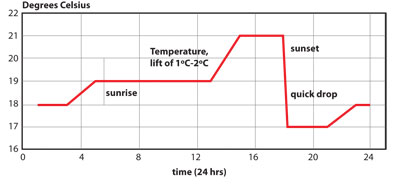 |
WHAT IS THIS 24-HOUR AVERAGE TEMPERATURE CONCEPT … AND WHY IS IT IMPORTANT?
■ Plants respond and adjust their growth based on average temperatures over 24 hours. This means day temperatures combined with night temperatures affect the growth of the plant.
To better understand this, I have provided the example of tomato plants. The table compared the growth under two temperature scenarios. Day and night temperatures are different, but the 24-hour average is the same.
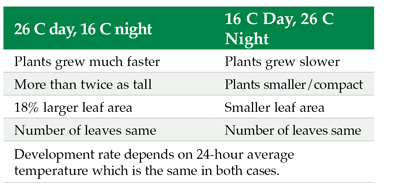 |
|
You will notice how these two temperature regimes affected the growth of the tomato plants, although the number of leaves remained the same.
How to calculate the 24-hour average temperature: Those growers who have computerized control can easily see this on their screens and can adjust the day or night temperatures accordingly. Growers who don’t have this capability can use the following calculation:
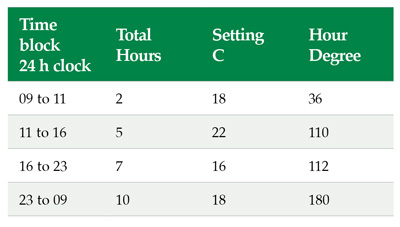
|
Add “Hour Degree” and divide by 24, that is 438 ÷ 24 = 18.3 C. As long as you understand this example, you can change the temperature in those time blocks and make the average temperature lower or higher. Growers with good computerized control use pre-night, early night, late night, pre-dawn, after dawn and mid-afternoon settings to make adjustments in the 24-hour average temperature.
So growers can calculate this number and steer the crop accordingly to a vegetative direction or a generative direction. Most of the time, if you can read the plant, then it will tell you what is happening.
You will usually find these plants near the edge of the greenhouse where it is cold. The leaves, flowers and clusters are huge. Any fruit set on these plants will show “cat-facing” – a big scar on the blossom end.
Just to recap, make sure you understand the importance of temperature during the 24-hour period and the importance of light in the context of temperature. I will talk more about temperature and the relationship with relative humidity and moisture deficit in a later feature. Just remember that one degree centigrade difference changes the humidity by five per cent.
EDITOR’S NOTE: Please note that we made an editing error in copying a chart in Dr. Mirza’s September 2012 feature. The correct chart is as follows:
Dr. Mohyuddin Mirza is a greenhouse consultant. • drmirzaconsultants@gmail.com
Print this page